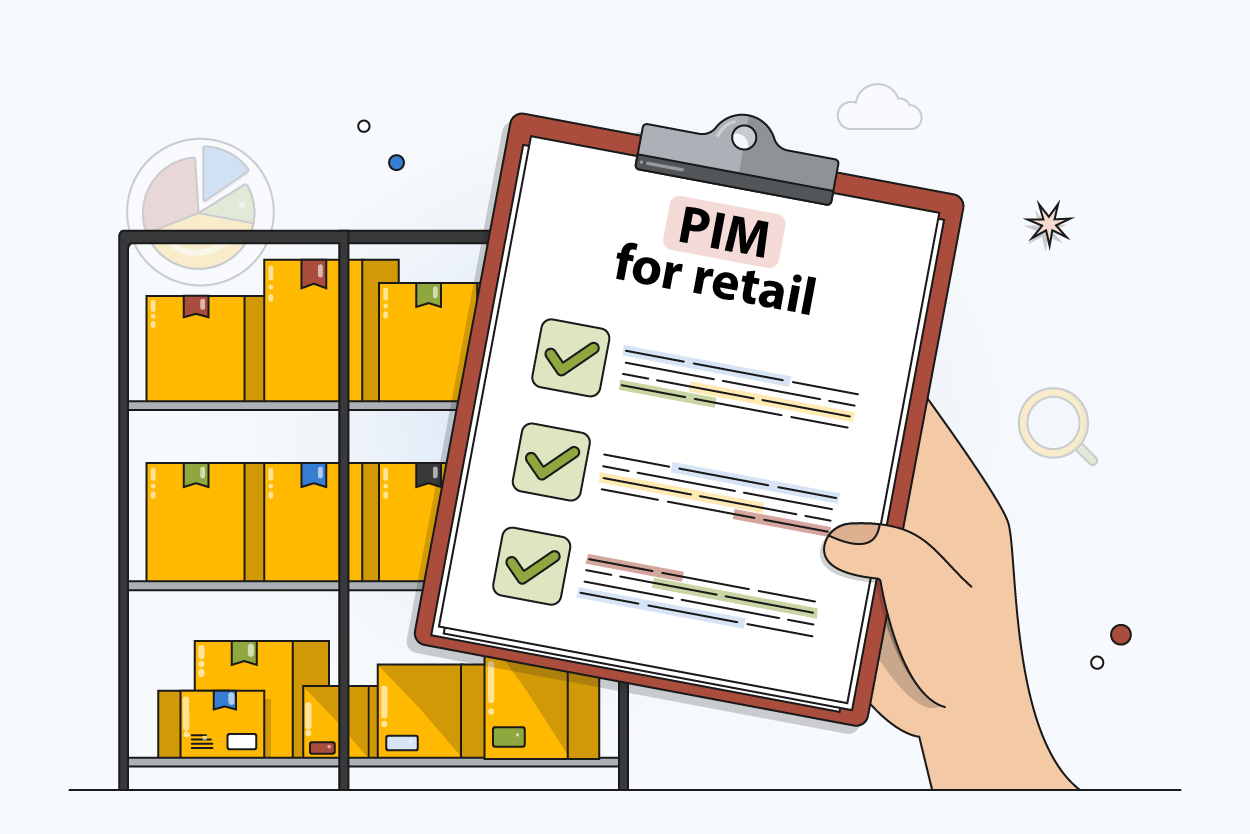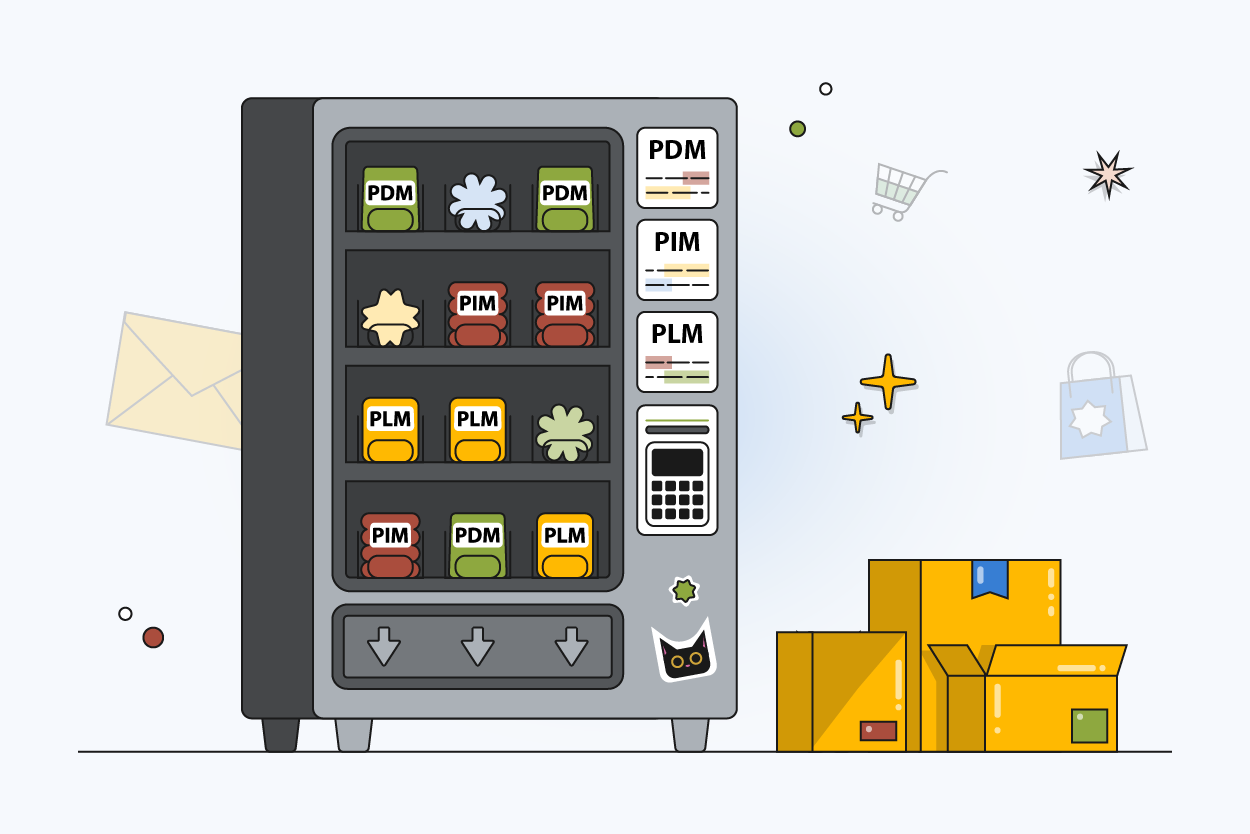Driving eCommerce Growth: A Comprehensive Guide to PIM
Author name: Mark Chickering

Lost in a maze of product attributes, data, digital assets, and marketing jargon? Not sure how to manage your product catalog? Fear not! PIM is here to be your guide through this overwhelming labyrinth of information.
No longer are you stumbling through the shadows of inaccurate product descriptions or dead-end alleys filled with outdated catalogs. With PIM at your side, each step brings clarity - richly detailed products that captivate online buyers and an optimized search engine presence that commands attention.
But what makes this guide so extraordinary? How can it transform a tangled web into a structured path leading straight to success?
By delving into the world of Product Information Management (PIM), we'll uncover how this guide can transform a tangled web into a structured path leading straight to success. This journey will arm you with insights on implementing effective PIM solutions for better business outcomes. Stay tuned; there’s much more than meets the eye!
Table of Contents:
- A PIM Systems Role and Importance
- The Need for PIM Across Various Business Roles
- Effective PIM System's Key Features;
- Benefits of Implementing a Robust PIM Solution
- Comparing Different PIM Solutions
- PIM System, Steps to Successful Implementation
- Ensuring Ongoing Success with Your Chosen PIM System
- The Strategic Value of PIM Systems
- Conclusion
- FAQs in Relation to PIM
A PIM Systems Role and Importance
Currently, due to its volume, managing extensive product data can be overwhelming for businesses. This is where a Product Information Management (PIM) system comes into play.
A PIM solution serves as an essential tool in business operations by centralizing product information. It gives companies an edge when it comes to organizing their digital product content, such as images, videos, brochures and other digital data related to products.
PIM systems also streamline data entry processes while maintaining the quality of marketing data. They create accurate and consistent records that help enhance online buyers' experience.
The Essence of a PIM in Business Operations
PIM software helps collect, manage and enrich product content and provide details about product features more efficiently. Businesses are now able to provide remarkable e-commerce experiences that satisfy customers more effectively than ever before.
This approach enhances your company's ability to engage with customers through enriched product content that resonates with them on multiple levels - visually appealing images/videos alongside informative descriptions about key features or benefits.
No more fussing over scattered spreadsheets or juggling various platforms just so you can update your e-commerce site. With PIM tools at hand, everything becomes more manageable and efficient—leading towards growth not only for your enterprise but also in terms of positive customer relations.
And here’s another interesting tidbit: according to research conducted by Ventana Research Group; companies who implemented robust pim solutions have reported significant improvements in time-to-market speed along with increased overall sales revenue numbers.
The fact is clear – utilizing a good PIM solution isn't merely optional anymore; it has become a necessary gear driving forward successful e-commerce strategies across different industries worldwide.
Don’t let your business lag behind. Understand the role and importance of a PIM system in today’s market, and see how it can transform your product management approach for the better.
Embrace the power of a Product Information Management (PIM) system. It centralizes and streamlines your product data, making product attributes and other digital resources like images or videos easy to organize. By enhancing data quality, PIM tools improve customer experience with enriched content that truly resonates. This isn't just an option—it's essential gear for driving successful e-commerce strategies, leading to higher conversion rates and boosting overall business performance.
The Need for PIM Across Various Business Roles
Within any organization, diverse roles need to harness the power of a good PIM tool. These tools are not exclusive to e-commerce managers or sales teams; they're essential across various departments.
PIM helps product teams streamline their work by serving as a single source of truth for all product data. This lets them manage and enrich product information efficiently, which in turn leads to better quality products and information reaching the market faster.
E-commerce managers also greatly benefit from using a robust PIM system. It gives them full control over how products appear on different sales channels and aids in providing an outstanding product experience. With this central repository, updating product listings is quick and easy without compromising accuracy.
Marketers can also reap benefits from PIM systems. They get access to enriched product data that can be used creatively for marketing campaigns, enhancing digital commerce strategies with accurate descriptions and key features at their fingertips.
A flexible solution like PIMinto is suitable for organizations of any size and industry, and manages product details effectively while keeping your team's productivity high.
Beyond Just Sales & Marketing: A Holistic Approach
Pioneering companies realize that Product Information Management isn't just about boosting online sales or improving SEO keywords - it plays a pivotal role throughout the entire organization. A PIM software platform allows everyone to benefit when there’s one reliable version of your business’ critical information. PIM Software's impact is crucial, whether it's finance managing budgets based on accurate SKU counts or logistics coordinating warehousing and deliveries according to product dimension attributes.
But let’s face it - managing vast amounts of complex data includes its challenges. Here is another aspect where a good PIM shines - it can help overcome some of the biggest challenges organizations face when dealing with product data.
So, from your logistics to marketing teams, and even C-suite executives who need an overview of the business operations – all can make informed decisions using a reliable PIM tool. PIM is no longer a mere convenience but an absolute necessity in the current digital business world.
Whether you're on a product team or in marketing, PIMinto PIM can be your go-to resource. It's about more than managing and enriching product data. This tool also amps up productivity and paves the way for innovative digital commerce strategies with its accurate, creative uses of enriched product information.
Effective PIM Software System's Key Features
A robust Product Information Management (PIM) system is the backbone of successful digital commerce. It's not just about keeping product info; it's also ensuring that the details are accurate, comprehensive, and ready to be spread out across a variety of sales outlets.
PIM platforms manage product data, import data from various sources, optimize it for search engine optimization (SEO), and deliver compelling product experiences. But let's delve into some key features that set apart a good PIM solution.
PIM Systems and Underlying Architecture
The PIM architecture plays a pivotal role in how effectively your PIM works. A top-tier option like API-driven service-oriented architecture, found in a solution like PIMinto, enables seamless integration with third-party software and headless e-Commerce.
This feature lets you sync all your marketing data to create consistent messaging throughout every touchpoint on the customer journey. Plus, when paired with ERP or enterprise resource planning systems - you've got yourself one powerful tool.
- Data Import & Export: This feature allows easy migration between different formats and standards so your team can focus more on delivering quality products rather than juggling file conversions.
- Digital Asset Management: Not only does this handle text-based content but also manages digital assets like images or videos – crucial elements that contribute significantly to creating compelling product listings.
- Data Quality Control: To make sure each listing paints an accurate picture for online buyers: typos are fixed promptly while inconsistencies get flagged down before causing any confusion among potential customers.
Benefits of Implementing a Robust PIM Solution
By centralizing product data, it helps to deliver consistent and compelling product experiences. But let’s break down these benefits further.
Improved Product Data Quality
Poorly managed or inaccurate product details can hamper customer experience. A good PIM system enhances your control over all aspects of product information – from descriptions to images and videos. This leads to higher-quality listings that customers trust.
In addition, having a single source of truth allows easy updates across multiple sales channels in real-time ensuring accurate product representation everywhere.
Better Customer Experience
Consumers nowadays are more knowledgeable than in the past. They need complete information about what they're buying. With enriched content from a centralized PIM platform, you provide them with everything they need - improving their overall shopping experience.
Compelling products experiences, anyone?
Optimized SEO Performance
Last but certainly not least: search engine optimization. The ability to manage SEO keywords within your high-quality product descriptions is critical for visibility on Google and other search engines.
This isn’t merely adding tags – think meta-descriptions and alt-texts too. So if someone asks “How does using PIM improve my rankings?” Now you know.
Note: While some might view implementing such a system as daunting, remember - the benefits far outweigh any initial setup challenges.
7 Reasons Why Your Business Needs a PIM Solution
Still deciding if PIM is right for you? Discover the key benefits that make PIM essential for modern eCommerce businesses.
Comparing Different PIM Solutions
Diving into the sea of Product Information Management (PIM) solutions, you'll find a variety of options. Some offer basic product listing features while others give more comprehensive capabilities like digital asset management and search engine optimization.
A key consideration when comparing these systems is how they handle product content. You want to choose a solution that allows for seamless data import and ensures your marketing data remains accurate and consistent across all sales channels.
PIM Software Spotlight on PIMinto
Picking out from the crowd, let's spotlight on one such flexible software - PIMinto. It stands out with its ability to consolidate various types of digital assets. This feature can be particularly beneficial for businesses dealing with large volumes of product details or those in need to enrich their product descriptions frequently.
A good PIM software should effectively manage visual assets in addition to managing text-based content, After all, compelling images and videos are vital components of delivering compelling product experiences online. Here too, PIMinto shines bright.
The PIM is designed to cater to organizations regardless of their size. Whether you're an e-commerce startup trying to keep up with rapidly changing inventory or an enterprise-level company juggling hundreds of thousands of SKUs at once – it fits all.
We know choosing between different PIM software solutions isn't easy but PIMinto offers a free pricing tier that allows you to try out it's advanced features without a financial commitment. Considering your unique business needs will guide you toward making the right choice. Ask PIM providers for free training on their platform and remember: every tool has its strengths. Identify your needs first then match them against what each platform offers.
Is Your Business Ready for PIM?
Take our 2-minute assessment and get personalized recommendations
- Analyze your current product data challengesGet instant recommendations based on your business profileSee which PIMinto plan fits your needsLearn if PIM will solve your specific problems
PIM System, Steps to Successful Implementation
The first step in implementing a successful Product Information Management (PIM) system is choosing the right software. You'll need something that can handle digital assets and data entry efficiently.
Your chosen PIM should have an easy-to-use interface, making it simpler for your team to manage product details. This will help streamline operations across your entire organization as your team works to deliver consistent results and manages product data.
Data Migration and Integration Best Practices
To get started with your new PIM solution, you’ll want to plan out how you’re going to migrate all existing product data into the system. Ensure all data is precise and current before starting the transfer process.
Migrating this wealth of information might seem daunting but don't fret. Just break it down into manageable chunks, starting with high-priority items like product descriptions or key features listings.
Beyond simply migrating data, consider which other systems in your company’s tech stack need integration with the PIM platform - things like ERP or CRM tools. The goal here is delivering consistent, enriching product experiences through seamless access to relevant data across different platforms.
Paving Way for Digital Commerce Success
A well-implemented PIM tool acts as a central source of truth for every single piece of important marketing content about each one of your products – from print catalogs on paper right through SEO keywords optimized online content reaching far-flung corners digitally.
Evaluating Your New System's Performance
Last but not least; make sure there are processes set up so that regular audits can be conducted on how effectively this newly implemented solution helps meet business objectives- such as reducing time market while also enhancing product syndication efforts.
These steps will ensure you get the most out of your PIM system, setting your business up for a future full of successful digital commerce operations. The key is to keep an eye on data consistency and accuracy, always striving to deliver compelling product experiences that set you apart from competitors.
With a solid PIM, businesses can manage their product data like champs. It's all about staying ahead in this digital-driven world.
Implementing a PIM system starts with picking the right software and planning your data migration. Remember, quality is key during this process. Integrating other systems like ERP or CRM tools helps ensure consistent product experiences across platforms. Regular audits of your new system's performance are crucial to maximizing its benefits for digital commerce success.
Ensuring Ongoing Success with Your Chosen PIM System
The journey doesn't end after implementing a PIM system. It's vital to measure success and provide necessary training for ongoing efficiency. Here are some strategies to consider.
Maintaining Accuracy of Product Information
To deliver compelling product experiences, it’s crucial to keep the information accurate across all sales channels. This involves routine checks and updates on your product data within the PIM system.
Promoting Continual Learning and Training
As your business evolves, so will its needs from a PIM solution. Regular training sessions can help teams adapt to changes effectively and leverage new features that might be introduced in future software updates.
Measuring Success with KPIs
A key aspect is setting up relevant Key Performance Indicators (KPIs) like time-to-market speed or data quality level which you can track regularly using analytics tools linked with your PIM system.
Incorporating User Feedback into Updates
Taking note of user feedback is critical as it provides insights about potential improvements in functionality or usability aspects of the chosen PIM platform. Actively addressing these concerns not only improves overall satisfaction but also boosts productivity among users who interact daily with the system.
All these measures collectively contribute towards achieving ongoing success with any given PIM Solution. Remember - commitment does not end at implementation; instead, consider this phase as just one milestone in an enduring journey towards perfecting product experience delivery.
The Ultimate PIM Selection Guide: 15 Critical Criteria
Ready to choose a PIM? Learn the 15 must-have features and evaluation criteria before making your decision.
The Strategic Value of PIM Systems
PIM plays an essential role similar to that of a conductor leading an orchestra. Without it, managing and synchronizing various elements such as marketing data and digital asset management becomes chaotic.
A quality PIM solution, according to key stats mentioned earlier, is akin to having someone harmonize your vast collection of musical instruments - each playing its own tune but creating a beautiful symphony when conducted properly.
Benefits of Implementing a Robust PIM Solution
Incorporating a robust PIM system isn't just about bringing order; it also has potential benefits, such as optimizing time to market by delivering consistent content across channels – making your products more attractive to buyers.
Think of it as giving your products a digital makeover, where everything from product listings to images and videos are enhanced. This results in a compelling product experience for customers - akin to stepping into an expertly curated boutique rather than rummaging through cluttered racks at a discount store.
A top-notch PIM works like a savvy digital librarian. It organizes and enhances product data with SEO keywords, serving different audiences—from online shoppers looking for detailed descriptions to managers in need of efficient resource management tools. Streamlining and synchronizing marketing data and assets, it introduces harmony into your business operations. But this goes beyond simply creating order—it also significantly optimizes time-to-market efficiency.
Conclusion
With PIM, your business is no longer lost in a maze of product data and digital assets. Instead, you're equipped with the right tools to navigate it effectively.
PIM isn't just an option; it's a necessity for managing extensive product information and enhancing customer experience. It's the bridge connecting various roles within your organization – from e-commerce managers to product teams.
A robust PIM system provides key features that streamline operations, optimize SEO efforts, and enrich product data across all sales channels. The result? Compelling products that captivate online buyers.
In conclusion: Embrace PIM. Transform your marketing data into compelling narratives about each item in your catalog. And watch as this newfound clarity drives eCommerce growth like never before!
Ready to Transform Your Product Data Management?
Centralize your product information, eliminate data inconsistencies, and accelerate time-to-market with PIMinto intuitive PIM solution.
FAQs in Relation to PIM
A Product Information Management (PIM) system centralizes and manages product data, enhancing accuracy and streamlining distribution across all sales channels.
PIM is a single source of truth that plays a key role in product management and eCommerce by improving product data quality. This leads to better customer experiences, ultimately driving sales growth and reducing time-to-market.
PIM systems have robust features like bulk editing of products, integration with other business tools like ERP and CRM software, advanced search functions for efficient data retrieval, and improved SEO performance through enriched content.
PIM improves eCommerce by centralizing product information, ensuring consistency across all channels, reducing errors, and enabling faster time-to-market. It also enhances SEO through enriched product descriptions and optimized content.
Modified on: 2023-10-18



